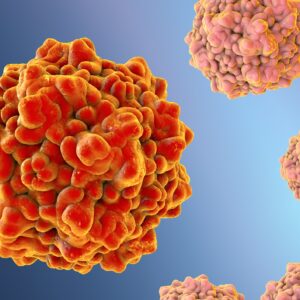Feline Calcivirus
Feline parvovirus (FPV) is the cause of a highly contagious and often lethal disease of cats and other felidae called feline panleukopenia (FPL), but also known as feline infectious enteritis (FIE) or feline distemper. FPV is ubiquitous in the environment and may survive for several months. It can cause high mortality rates in unvaccinated populations, and kittens are particularly susceptible. No specific treatment is available for FPV infection but there are effective vaccines available for prevention.
Feline Parvovirus Background
Feline parvovirus (FPV), also known as feline panleukopenia virus (FPLV), causes a severe disease in cats, particularly kittens, and can infect all wild and domestic members of the felid family worldwide. When Canine parvovirus 2 (CPV-2) first emerged in the 1970s, it could not replicate in cats. However, all current CPV variants (CPV-2a-c) can infect cats to cause subclinical disease or FPL (Barrs,2019). CPV and FPLV isolates differ in less than 2% of their genomic DNA sequences and it is thought that CPV-2 arose from a variant of FPLV or a closely related virus infecting another carnivore, such as mink or foxes (Ikeda et al., 2002).
Feline parvovirus is ubiquitous in the environment, and most kittens and cats are exposed to the virus at some point in their lives. Infection is spread by direct faecal-oral contact, and indirectly following contamination of the environment or objects (e.g., on food dishes, grooming equipment, bedding, floors, clothing or hands). Cats infected with FPLV can continue to excrete the virus for at least six weeks following infection, and the virus can also be transmitted by dogs. The signs of FP can vary and may be similar to other illnesses such as Salmonella or Campylobacter infection, pancreatitis, feline immunodeficiency virus (FIV) infection, or feline leukemia virus (FeLV) infection.
FPV infects and kills cells that are rapidly growing and dividing, such as those in the bone marrow, intestines, and the developing fetus. In kittens over three or four weeks of age and in adult cats the virus causes a very severe gastroenteritis, following an incubation period of five to nine days. Affected cats develop acute onset haemorrhagic vomiting and diarrhoea and some cats die rapidly. The virus causes severe damage to the lining of the intestine and also travels via the blood to the bone marrow and lymph glands. Viral replication at these sites leads to a marked depletion of white blood cells. In pregnant cats the virus can spread to the unborn kittens where it may interfere with the developing brain, causing a condition known as cerebellar hypoplasia, and ultimately leading to greatly uncoordinated movement.
Feline parvovirus is a highly contagious disease and no specific treatment is available for it. However, effective vaccines are available and vaccination and disinfection are important in the prevention of disease transmission in multi-cat environments. The likelihood of recovery of infected kittens less than eight weeks old is poor. Mortality rates are high and may be over 90% in kittens (Truyen et al., 2009). Older cats have a greater chance of survival if adequate treatment is provided early. If the cat survives for five days, its chances for recovery are greatly improved (Stuetzer & Hartmann, 2014).
References
- Barrs VR. (2019). Feline Panleukopenia: A Re-emergent Disease. Vet Clin North Am Small Anim Pract.;49(4):651–670.
- Ikeda et al. (2002). Feline host range of canine parvovirus: recent emergence of new antigenic types in cats. Emerging infectious diseases vol. 8,4 341-6.
- Parrish CR. (1995). Pathogenesis of feline panleukopenia virus and canine parvovirus. Baillieres Clin Haematol. 8(1):57–71.
- Stuetzer B, Hartmann K. (2014). Feline parvovirus infection and associated diseases. Vet J.;201(2):150–155.
- Truyen U, Parrish CR. (2013). Feline panleukopenia virus: its interesting evolution and current problems in immunoprophylaxis against a serious pathogen. Vet Microbiol. 165(1-2):29–32.
- Truyen et al. (2009). Feline panleukopenia. ABCD guidelines on prevention and management. J Feline Med Surg. 11(7):538–546.
Feline Parvovirus Antigens
The Native Antigen Company is pleased to provide a native feline parvovirus antigen for all of your assay development and research needs.
Questions?
Check out our FAQ section for answers to the most frequently asked questions about our website and company.

